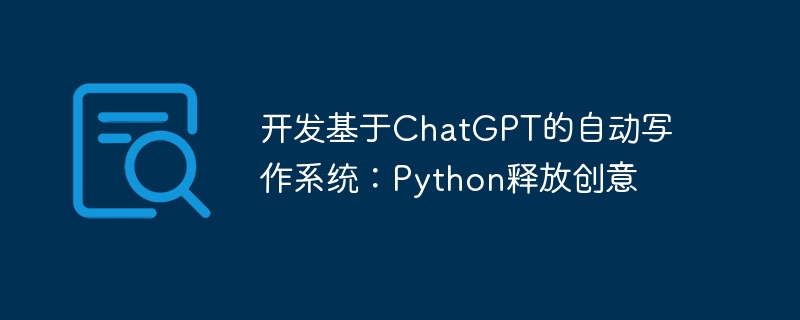Home >Backend Development >Python Tutorial >Developing an automatic writing system based on ChatGPT: Python unleashes creativity
Developing an automatic writing system based on ChatGPT: Python unleashes creativity
- WBOYWBOYWBOYWBOYWBOYWBOYWBOYWBOYWBOYWBOYWBOYWBOYWBOriginal
- 2023-10-24 08:20:101382browse

Developing an automatic writing system based on ChatGPT: Python releases creativity
1. Introduction
The automatic writing system is a method that uses artificial intelligence technology to generate articles and poems , stories and other literary works. With the rapid development of artificial intelligence technology, automatic writing systems based on ChatGPT have attracted widespread attention in recent years. This article will introduce how to develop an automatic writing system based on ChatGPT and give specific code examples.
2. Overview of ChatGPT
ChatGPT is a chat agent system launched by OpenAI in 2020 based on a generative pre-training model. It has powerful language understanding and generation capabilities through large-scale text data pre-training. We can fine-tune it based on ChatGPT so that it can generate corresponding text based on user input.
3. Data preparation
To develop an automatic writing system, you first need to prepare training data. A large amount of text data such as literary works, poems, stories, etc. can be crawled from the Internet as training data. Organize this data into a text file, with each line being a sentence or a paragraph.
4. Model training
The code examples for using Python for model training are as follows:
import torch
from transformers import GPT2Tokenizer, GPT2LMHeadModel
from torch.utils.data import Dataset, DataLoader
class TextDataset(Dataset):
def __init__(self, data_path, tokenizer):
self.tokenizer = tokenizer
self.data = []
with open(data_path, 'r', encoding='utf-8') as f:
for line in f:
line = line.strip()
if line:
self.data.append(line)
def __len__(self):
return len(self.data)
def __getitem__(self, index):
text = self.data[index]
input_ids = self.tokenizer.encode(text, add_special_tokens=True, truncation=True)
return torch.tensor(input_ids, dtype=torch.long)
def collate_fn(data):
input_ids = torch.stack([item for item in data])
attention_mask = input_ids.ne(0).float()
return {'input_ids': input_ids, 'attention_mask': attention_mask}
data_path = 'train.txt'
tokenizer = GPT2Tokenizer.from_pretrained('gpt2')
model = GPT2LMHeadModel.from_pretrained('gpt2')
dataset = TextDataset(data_path, tokenizer)
dataloader = DataLoader(dataset, batch_size=4, collate_fn=collate_fn, shuffle=True)
device = torch.device('cuda' if torch.cuda.is_available() else 'cpu')
model.to(device)
optimizer = torch.optim.Adam(model.parameters(), lr=1e-5)
for epoch in range(5):
total_loss = 0.0
for batch in dataloader:
batch = {k: v.to(device) for k, v in batch.items()}
outputs = model(**batch, labels=batch['input_ids'])
loss = outputs.loss
total_loss += loss.item()
optimizer.zero_grad()
loss.backward()
optimizer.step()
print('Epoch:', epoch, ' Loss:', total_loss)During the training process, we used GPT2Tokenizer to convert text data into the input format required by the model. And use GPT2LMHeadModel for fine-tuning training.
5. Text generation
After the model training is completed, we can use the following code to generate text:
def generate_text(model, tokenizer, prompt, max_length=100):
input_ids = tokenizer.encode(prompt, add_special_tokens=True, truncation=True, return_tensors='pt')
input_ids = input_ids.to(device)
output = model.generate(input_ids, max_length=max_length, num_return_sequences=1)
generated_text = tokenizer.decode(output[0], skip_special_tokens=True)
return generated_text
prompt = '在一个阳光明媚的早晨,小明和小红走进了一家魔法书店,'
generated_text = generate_text(model, tokenizer, prompt)
print(generated_text)In this code, we can generate the corresponding text based on the given prompt. text. The generated text can be used as a source of creative inspiration for further creation and modification.
6. Optimization and Improvement
In order to improve the quality of generated text, we can improve the results by generating text multiple times and selecting the best paragraph. You can also improve the performance of the model by adjusting the hyperparameters of the model and increasing the amount of training data.
7. Summary
Through the introduction of this article, we have learned how to develop an automatic writing system based on ChatGPT. We train the ChatGPT model and use this model to generate text. This automatic writing system can provide authors with inspiration and help them solve creative problems during the writing process. In the future, we can further study and improve this system so that it can generate text more accurately and interestingly, releasing more creativity for creators.
The above is the detailed content of Developing an automatic writing system based on ChatGPT: Python unleashes creativity. For more information, please follow other related articles on the PHP Chinese website!

